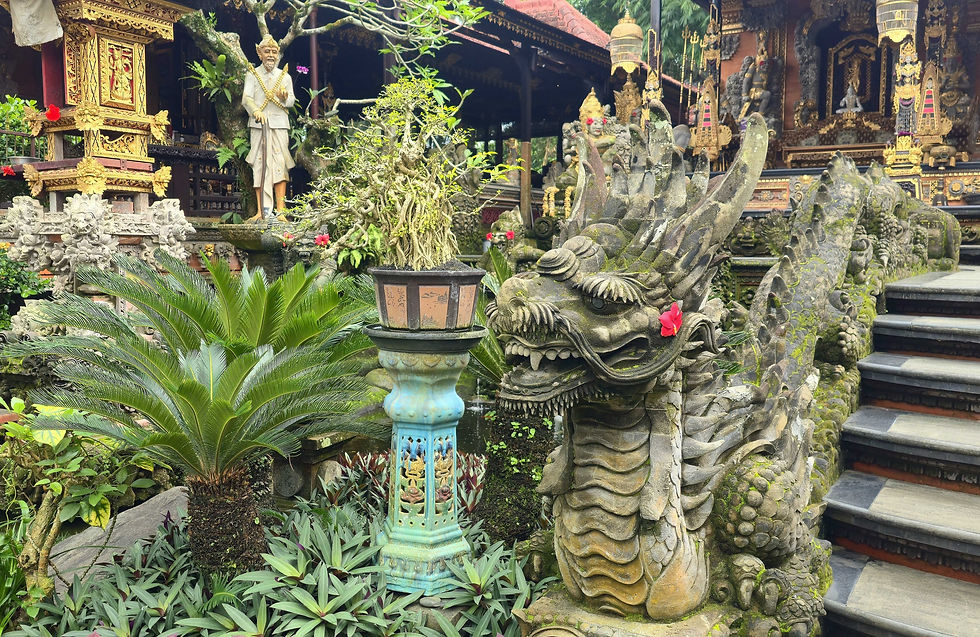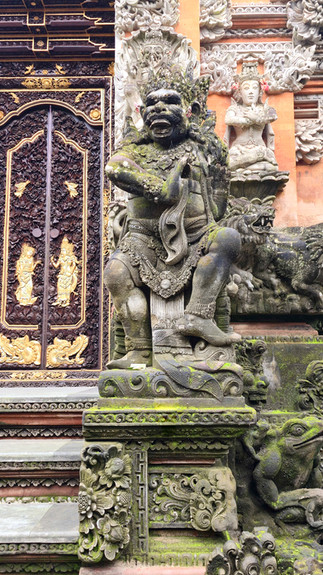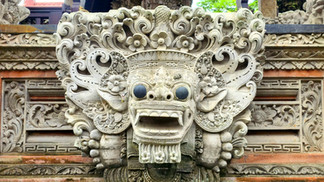Puri Langon Temple
- Shannon
- Sep 1
- 3 min read
Updated: Sep 16
Royal Estate in the Heart of Ubud
Puri Langon is a privately owned royal compound located in central Ubud. It is the brainchild and personal residence of Tjokorda Ngurah Suyadnya, better known as Cok Wah, a respected figure in the Ubud royal family. Though it remains a functioning private home, Puri Langon is open to the public free of charge, offering rare access to a lived-in royal space that continues to serve spiritual and cultural functions within the community.

Cok Wah is the seventh generation crown prince and son of the late King of Ubud. He is a member of the Ksatriya caste, traditionally associated with governance and military leadership. Ksatriyas often carry titles such as "Tjokorda" or "Anak Agung" and have long held influential roles in Balinese kingdoms. While Cok Wah does not hold an official royal title, he is widely recognised as a Prince of Ubud due to his noble lineage and active role in cultural and spiritual life. Deeply connected to Ubud, Cok Wah is also known for his work as a film producer, creating documentaries and features that preserve and promote Balinese heritage, ritual practices and identity.

The construction of Puri Langon took approximately six years and was completed around late 2013, at an eye watering $80-100 million USD. The build was not outsourced to commercial developers, instead, it was carried out with deep intention by local craftsmen, carvers and temple builders. Every structure, statue and pathway was designed according to Balinese sacred geometry, combining architecture, cosmology and ritual function into a unified spiritual environment.

Visitors enter the compound through carved stone gates, stepping into a serene space shaped by ritual order and artistic mastery. The layout reflects traditional Balinese spatial orientation, with sacred zones and ceremonial platforms embedded in a natural flow. While the site contains elements typical of a temple, it is foremost a private, spiritual sanctuary, created as both a home and a cultural offering to the community.

One of the most extraordinary features of Puri Langon is its collection of temple statues. Each figure, whether a guardian, deity or ancestor, was commissioned specifically for this site. Many are life sized or larger, draped in ritual cloth and adorned with daily offerings. The craftsmanship reflects the classical Balinese stone carving tradition, where facial expressions, hand gestures (mudras) and postures are deeply symbolic and spiritually activated.

Surrounding these structures is a network of sacred gardens, not just decorative but devotional. Ponds filled with koi, moss covered stone bridges and hidden shrines under trees create a sense of quiet mysticism. The natural elements are not separate from the architecture, they are integral to it, reinforcing Tri Hita Karana, the Balinese concept of harmony between humans, nature and the divine. These gardens are tended not only for beauty but for ritual balance.

Despite its scale and cost, Puri Langon remains uncommercial and understated. There are no entrance fees, guides or souvenir stands, just an open gate and the quiet hum of birdsong. Visitors are welcome to walk the grounds with respect. Some encounter Cok Wah himself, a man equally devoted to ceremony, heritage and modern cultural storytelling. Puri Langon Temple is not a monument to the past but a living bridge between Bali’s royal lineage and its spiritual future.

🗺️ Location
Gang Mawar, Ubud, Kecamatan Ubud, Kabupaten Gianyar, Bali, Indonesia
🚆 How to get there
This castle is located 1.1km's from Ubud Palace and will take roughly 15-20 minutes to walk to. Head straight up Jalan Suweta until you reach a small laneway called Gang Mawar on the left hand side. Puri Langon is on the right. If it's too hot or too far to walk, you can get a Go-Gek or Grab motorbike for a couple of bucks.
⭐ Attraction Info
Puri Langon is open daily between 9am - 6pm but please note that it also serves as a venue for private events, film shoots and family ceremonies. As a result, it may occasionally close without notice, depending on their schedule. While Puri Langon is open to the public, it is first and foremost a private home, an active royal residence where daily life and spiritual practice continue. Visitors are welcome to explore the grounds but it’s essential to do so with respect and quiet awareness. Please dress modestly, speak softly and avoid entering closed or clearly private areas. This is not a museum but a living space generously shared, treat it with the reverence it deserves. This gorgeous temple is yet to hit the insta circuit so you will likely find yourself there alone.


Thanks for reading about Puri Langon Temple. Check out more awesome destinations here!















































